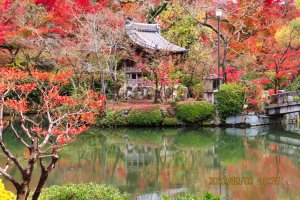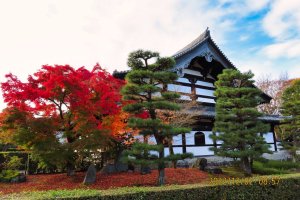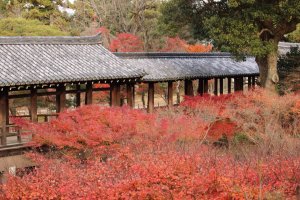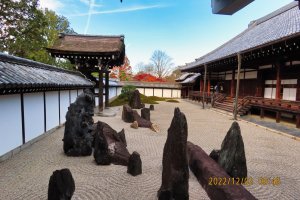Last evening, we mapped out our destinations for day two, using the digital board in the lobby of our hotel indicating the fall color hot spots. Most of the places we were visiting today are Important Cultural Properties or Places of Natural Beauty.
Our first stop was a short train ride from Kyoto to Tofukuji station. During fall the temple grounds open at 8:30 a.m. We arrived early in order to beat the crowds.

Tofuku-ji Temple
This temple is one of the five great temples of Kyoto. It was established in 1236 Destroyed by fire in the 15th century and in 1881. There were originally 70 buildings, currently 25 with the main hall being reconstructed in 1917. The main gate is the oldest in Japan. The fall colors were so brilliant surrounding the Tsuten-kyo building. There are four unique gardens. The Southern Garden, which represents the Elysian Islands were neatly landscaped with rocks and sand. We boarded another train to Keage station for a short walk to Nanzenji Temple.

Nanzen-ji Temple
Established in 1291 Nanzen-ji covers a large area with many sub temples. As you walk the grounds you will notice the historic aqueduct that was constructed in the late 1800`s to carry water from Lake Biwa to Kyoto. Our next sites were all within walking distance of Nanzen-Ji.

Breizh Café
On the way to Eikando Temple, we noticed a nice French style café and decided to have a mid-morning coffee. Breizh Café has been in this location for a little over a year, previously in central Kyoto for 7 years. For the morning menu they specialize in crepes and we could not resist. Our waitress Yuka eagerly answered all our questions and the service was excellent. The buckwheat flour crepes were so good, I could have gone for seconds. This was a great find and a reason to come back to this area on our next visit.

Eikando Zenrin-ji Temple
Known as the Temple of maple leaves, Eikando established 1100 years ago, was one of my favorites on this trip. You could spend hours here walking the large grounds. From the entrance up to the main temple, the red hue of the maples kept encouraging us to continue on. We climbed the stairs up to the pagoda and were rewarded with a panoramic view of Kyoto and the nearby mountains. Continuing on down towards the exit we came up Hojo-ike Pond where the reflections of the trees and the bridge were spectacular. Another fifteen minute walk with some up hill exercise we came to Shinnyodo Temple.

Shinnyodo Temple
Established in 984 Shinnyodo is not as famous as the ones we have visited, but the fall colors were still worth the walk. An added plus is there were few people, making the grounds quiet and easy to take pictures. The trees around the three-story Pagoda made the building that more colorful.
We walked less steps than day one and spent the remainder of the day exploring inside Kyoto station.































